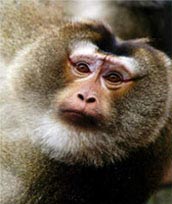Pig-tailed Macaque
(Macaca nemestrina)
Habitat: tropical and sub-tropical forests.
Feeding habits: pick up fruits and leaves in trees or catch small living creatures on the ground.
Food: wild fruits, young leaves of vegetations, insects and small birds.
Size: with a body length of 50-66 cm and a tail length of 17-32 cm.
Habits: live in broad-leaved forests in groups and often act on the ground. The top of its head is flat and with a whorled in its hairs. The tail of it is like that of a pig; therefore, it is called "flat-headed macaque" or "pig-tailed macaque". In Thailand, pig-tailed macaques are trained to pick up coconuts. A pig-tailed macaque can pick up more than 1000 coconuts a day.
Category: mammalia, primates, macaque.
Distribution: only in the Southwest of
Yunnan.
Level of protection: class I key state protection animal of China


|